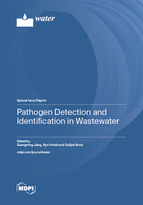Pathogen Detection and Identification in Wastewater
A special issue of Water (ISSN 2073-4441). This special issue belongs to the section "Wastewater Treatment and Reuse".
Deadline for manuscript submissions: closed (20 August 2023) | Viewed by 50143
Special Issue Editors
Interests: microbiologically influenced concrete corrosion; bio-concrete; corrosion-resistant concrete; sewer corrosion and odour management; corrosion processes; free nitrous acid; environmental microbiology; biocorrosion testing
Special Issues, Collections and Topics in MDPI journals
Interests: antimicrobial resistance and SARS-CoV-2 in wastewater and water environment; membrane-applied process for wastewater treatment
Special Issue Information
Dear Colleagues,
The COVID-19 pandemic has renewed research needs on the detection and monitoring of various pathogens in urban wastewater systems. Not only have the detection methods evolved from culture-based to molecular-based technology over the years, but also the purposes and applications have expanded from water quality monitoring to wastewater-based epidemiology (WBE). To ensure the effectiveness of wastewater treatment and the protection of public health, much research has been done to enhance wastewater sampling, pathogen recovery and concentration, detection sensitivity and specificity, and data analysis and modelling. These recent developments allow the more accurate and timely identification of the occurrence of pathogenic bacteria and viruses in wastewater. Meanwhile, it is still a challenge to detect new pathogens, such as SARS-CoV-2, at very low levels in wastewater. Significant research is needed to improve the detection and identifiction capability for any emerging pathogens. Genome sequencing methods are promising in providing comprehensive information including the identification of pathogens, resistance genes, and the design of PCR probes.
Public health and safety impose an ever-increasing importance on the fate and spread of pathogens in wastewater systems. To address the research needs for the detection and identification of pathogens in wastewater, we would like to invite research articles or review papers working on various aspects, including, but not limited to:
- Rapid detection and identification methods
- Detection of new pathogens
- Development of biosensors
- Sequencing-based methods
- WBE studies for pathogens in wastewater
- Optimisation of conventional methods
- Sampling methods or passive samplers
- Antimicrobial resistance in wastewater
Dr. Guangming Jiang
Dr. Ryo Honda
Dr. Sudipti Arora
Guest Editors
Manuscript Submission Information
Manuscripts should be submitted online at www.mdpi.com by registering and logging in to this website. Once you are registered, click here to go to the submission form. Manuscripts can be submitted until the deadline. All submissions that pass pre-check are peer-reviewed. Accepted papers will be published continuously in the journal (as soon as accepted) and will be listed together on the special issue website. Research articles, review articles as well as short communications are invited. For planned papers, a title and short abstract (about 100 words) can be sent to the Editorial Office for announcement on this website.
Submitted manuscripts should not have been published previously, nor be under consideration for publication elsewhere (except conference proceedings papers). All manuscripts are thoroughly refereed through a single-blind peer-review process. A guide for authors and other relevant information for submission of manuscripts is available on the Instructions for Authors page. Water is an international peer-reviewed open access semimonthly journal published by MDPI.
Please visit the Instructions for Authors page before submitting a manuscript. The Article Processing Charge (APC) for publication in this open access journal is 2600 CHF (Swiss Francs). Submitted papers should be well formatted and use good English. Authors may use MDPI's English editing service prior to publication or during author revisions.
Keywords
- pathogen detection
- wastewater-based epidemiology
- sewer
- wastewater treatment plant
- bacteria
- viruses
- biosensor
- PCR
- DNA sequencing
- antimicrobial resistance
- quantitative risk assessment
- variants of concern
- early warning of outbreaks
- transmission monitoring
- wastewater surveillance








